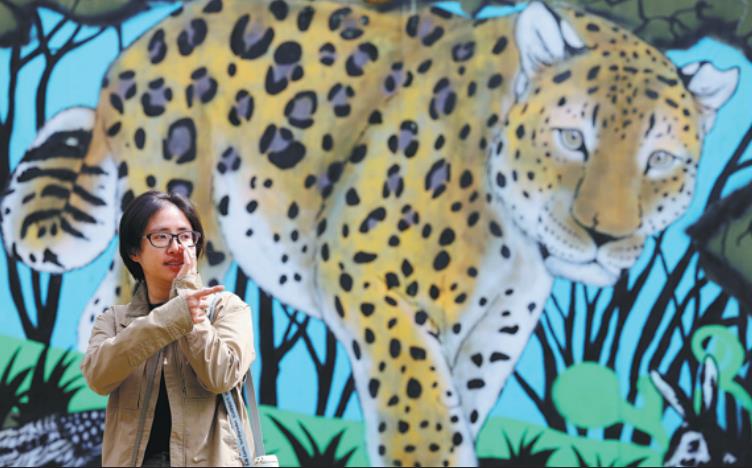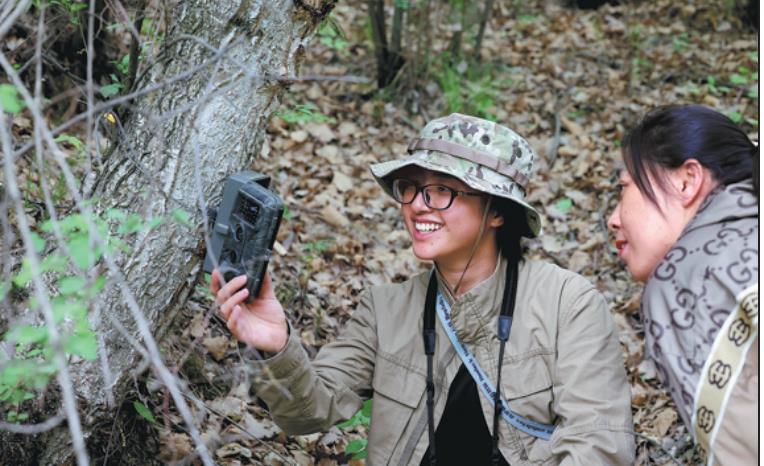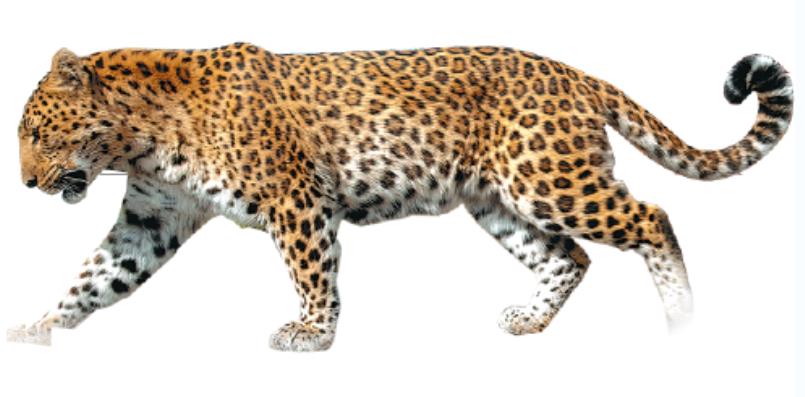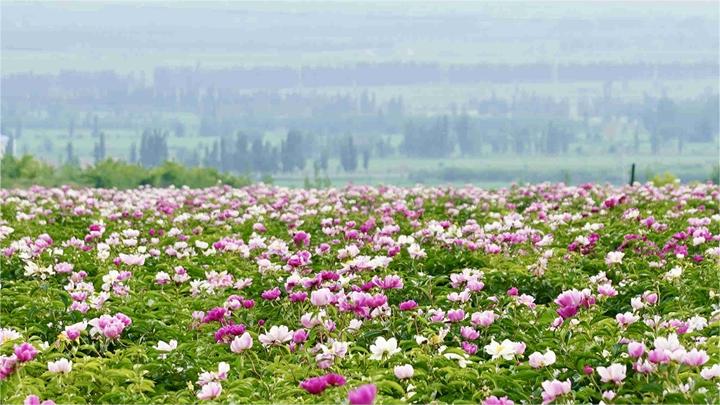Mountain county changes its spots to ensure leopards thrive

Huang Qiaowen, executive director of the Chinese Felid Conservation Alliance, stands in front of a mural of a North China leopard in Heshun county, Shanxi province. (ZHU XINGXIN/CHINA DAILY)
Located at the end of a road in the Taihang Mountains, Leyi village has only 42 households with 70 residents, whose average age is 65. The densely vegetated mountains that surround the sparsely populated rural community, which has three residential areas, add to its sense of isolation from the outside world.
Recently, however, the village in Heshun county, Shanxi province, had an unusual horticultural activity. Over 10 villagers, most with gray hair, did something they had never done before when they planted flowering shrubs on ridges among farm plots.
The villagers are a key part of the Baoxiangtian project, which aims to restore natural habitats for vulnerable North China leopards. According to the project's initiator, the Chinese Felid Conservation Alliance, a nonprofit organization specializing in the protection of wildcats in China, "bao" stands for the leopard, "xiang" for villagers, and "tian" for farmland.
The alliance, which has protected the North China leopard in Heshun for a decade, envisions a revitalized Leyi where both people and leopards thrive. The project aims to establish comprehensive biodiversity through eco-friendly and sustainable agricultural practices, said Huang Qiaowen, executive director of the alliance.
The program is an example of the multi-stakeholder governance model used for North China leopard conservation in Heshun, which involves not only the government but also social organizations, research institutions, and local communities.
A leopard subspecies native to China, North China leopards are under top national-level protection in China and were included on the International Union for Conservation of Nature's Red List of Threatened Species in 2012.
From May 2015 to June 2020, a total of 89 adult North China leopards were identified in Heshun, local authorities said.
The county's North China leopards stand out as the "sole visibly healthy and continuously expanding" population of the species in China, the Ministry of Ecology and Environment said in a media release early last year.
It is a "unique population source "for the continuation of the endangered animal, and Heshun plays a crucial role as a key channel for the animal's dispersal, the release stated.

Huang checks an infrared camera, which captures the action of the leopards in Heshun. (ZHU XINGXIN/CHINA DAILY)
Habitat integrity
The alliance's monitoring, aided by infrared cameras, revealed the presence of six North China leopards within a 20-kilometer radius of Baoxiangtian, Huang said. On Feb 9, the eve of this year's Spring Festival, the area was graced by a female leopard and three cubs, she added.
This density of the animals is notably high for the species, considering that the territory of a male North China leopard may extend beyond 100 square km, though that of a female is usually much smaller.
Visitors standing in the Baoxiangtian project area may see no obvious signs indicating the presence of the carnivorous animal, which is known to avoid the presence of humans. But, they might chance upon traces of the shy creature if they venture into the mountains.
In a small hollow enveloped by trees, located less than half a km from Baoxiangtian, the scattered bones of a wild boar lay on the ground. Some parts are slightly weathered and blackened. These remnants were left by a North China leopard after it had fed on its prey.
The wide and deep valley where Baoxiangtian is nestled between two lush hills, should ideally be a favored roaming ground for wild animals. However, farming has disrupted the living environment of these creatures, contributing to the fragmentation of the North China leopard's habitat.
To address the problem, the alliance leased 5.6 hectares of farmland in the valley last year. The alliance aspires to restore the valley to a thriving habitat for wild animals by diversifying the crops and vegetation without using any chemicals.
The Baoxiangtian operation also generates a steady income for local villagers. The alliance has established a cooperative named after Baoxiangtian and employs 11 villagers to assist with its operations, Huang said.
Last year, the alliance distributed harvests from Baoxiangtian, including corn, to the alliance's funding donors. "The produce was highly praised," she said with a gentle smile on her tanned face, a result of working in Baoxiangtian for a long time.
This year, the alliance plans to launch a farmland "adoption" program to connect Baoxiangtian with people from afar who share a deep concern for the North China leopard. Donors can adopt a plot of farmland as small as 1 square meter for an annual fee of 59 yuan ($8.30) to support the cooperative's operations, she explained.
Those adopting more than 5 sq m will receive an annual allocation of 3 to 5 kilograms of produce from Baoxiangtian, she added.

Villagers plant trees on farm plots in the area of the Baoxiangtian project. (ZHU XINGXIN/CHINA DAILY)
Concerted efforts
Prior to the Baoxiangtian initiative, the alliance worked with local communities and authorities for a decade to explore solutions to enhance the protection of endangered animals.
In April 2015, for example, with support from the government of Mafang township, which Leyi belongs to, the alliance funded the establishment of a patrol team named after laobaozi, the name for the North China leopard in the area.
The team, which has grown from five members to 20, is not only tasked with collecting data from the 400 infrared cameras the alliance has installed but also conducts patrols to prevent poaching.
Qi Qiantang from Leyi is one of the team's first members. He retired from the team last year at age 75. In a TV cabinet in his home, there is a photo of him with an image of a North China leopard. The picture sits beside a family photo.
"We cleared the traps people set to catch wild animals, and few traps have been detected in recent years, as people have an increasing awareness about protection (of wildlife)," he said.
Team members collect data from the infrared cameras every two months, and for their work, they can receive up to 6,000 yuan per year.
Qi is still engaged in alliance activities and was one of those who planted the shrubs. He also helps the alliance maintain a vegetable garden, which earns him a daily income of at least 150 yuan.
Without such programs run by the alliance, the villagers would hardly have any income, he said.
Aside from farming, many villagers in the area also raise cattle for a living. However, it has been difficult for them to earn a decent income in recent years following sharp decreases in beef prices.
"The operations of the alliance bring us a good income, and that also protects the animals," Qi noted.
He said the alliance has also issued megaphones to residents with recording and flashing light functions to help them frighten away wild boars that sometimes ravage crops. This way, the villagers don't need to resort to means that may hurt or even kill the animal, which is a common prey of the North China leopard.
Patrol teams
A team of over 100 members conducts patrols to add to the conservation of the North China leopard, said Li Ruiping, director of the Tieqiao Mountain Provincial Nature Reserve. The group comprises Laobaozi team members, rangers from the reserve, and rangers hired by the local government.
Covering about 35,352 hectares, the reserve was officially established in 2010 with its priority being protection of the North China leopard. Leyi village is located within the reserve.
Recognizing the North China leopard's preference for habitats with abundant cover, the reserve has prioritized afforestation efforts, Li said. Over the past three years, approximately 66.7 hectares of trees have been planted to help restore the leopard's natural habitat.
Ten small ponds were dug along natural watercourses to improve access to water for the leopard's prey species.
Plans are also underway this year to enhance North China leopard monitoring using more advanced means, Li said.
Tracking collars will be used, and rangers will collect fecal samples for genetic analysis to assess reproductive connectivity between different North China leopard communities, he said.
The Tieqiao reserve, together with 11 reserves and forest administrations in Shanxi, will also conduct joint monitoring starting this year to learn about the species' level of reproductive exchanges, he said.
Huang said the alliance is in close communication with local authorities on the issue of North China leopard conservation.
"We meet with county heads at least three to four times a year," she said, adding they have more frequent interaction with lower-level officials.

(ZHU XINGXIN/CHINA DAILY)
Local authorities also turn to them sometimes for information about North China leopard conservation. This happened last year when the local government was applying for an interest-free loan from the World Bank to support the construction of ecological corridors in the reserve.
In a draft plan, Northeast Forestry University proposed building five such corridors. After considering the alliance's suggestion to build 11, the local government increased the number of corridors to eight, she said.
In 2022, the county government also accepted the alliance's advice to designate 782 sq km of land as core areas for North China leopard conservation where development is banned, Huang said
Standing amid the Baoxiangtian project, Huang said she was optimistic the project would succeed on multiple levels.
The flowering shrubs attract insects that are natural predators of crop-eating pests, aiding insect control on the farmland, she explained. In addition, crops such as sesame will be grown to provide food sources for birds.
She said the alliance anticipates the ridges will be transformed into habitats suitable for lizards, snakes, and small birds that may draw predatory raptors.
"This is a cafeteria for all forms of life," Huang said.
Photos
Related Stories
- Red-footed boobies seen hunting flying fish in South China Sea
- Rescued whale released in south China
- Pic story: deep bond between French scientist and Chinese white dolphins
- Peak season arrives for Tibetan antelope migration to Hoh Xil
- Animals enjoy special Zongzi ahead of Dragon Boat Festival in Yunnan
- In pics: Yunnan golden hair monkey at Baima Snow Mountain National Nature Reserve
Copyright © 2024 People's Daily Online. All Rights Reserved.









